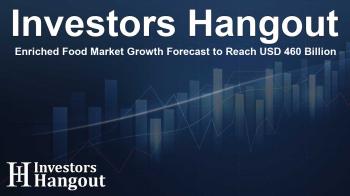Enriched Food Market Growth Forecast to Reach USD 460 Billion

Overview of the Enriched Food Market
The global enriched food market is experiencing a significant transformation, with the size anticipated to skyrocket from USD 196.33 billion in 2025 to an impressive USD 460.30 billion by 2034. This marks a robust compound annual growth rate (CAGR) of 9.93%. For many consumers, the drive towards healthier eating options and lifestyle choices is a primary catalyst behind this growth.
The Rise in Demand for Enriched Foods
As consumers become more informed about health, the demand for enriched foods has soared. People are increasingly inclined to enhance their diets to include products that not only satisfy hunger but also provide essential nutrients. The emphasis is on fulfilling nutritional gaps and fostering a healthier lifestyle, this means, for instance, a move towards protein-rich snacks and fortified cereals.
Understanding Enriched Foods
Enriched foods are those that have had vital nutrients added back following processing losses, primarily to restore their nutritional integrity. This often involves incorporating vitamins and minerals like iron, folic acid, and B vitamins. Adding these nutrients helps combat deficiencies, especially in populations that may rely heavily on processed foods.
The Current Market Landscape
With an emphasis on a balanced diet, consumers are now willing to invest in higher-quality nutritional food options. The online marketplace and physical stores are abundant with fortified food products designed to meet essential health requirements. Target demographics include health-conscious individuals, expectant mothers, and nutrition-savvy younger generations.
Key Trends Shaping Enriched Food Market
Recent trends affecting the enriched food sector include a surge in lifestyle diseases, prompting consumers to pursue healthier alternatives actively. Health organizations and government initiatives focusing on promoting nutrient-rich diets also contribute to this evolution.
Technology’s Role in Food Innovation
Artificial Intelligence (AI) is becoming integral to the food industry, promoting efficiency and innovation. Companies leverage data analytics and machine learning to create personalized nutrition solutions, addressing individual dietary needs. This technological advancement helps in rapidly developing products that meet the highest nutritional standards while ensuring safety.
Recent Market Developments
New brands like Nourifyme launched by Jindal Rice Mills in India, which offers fortified staples such as rice and wheat flour, highlight the collaborative effort between public and private sectors to enhance nutrition in the population. Furthermore, companies like Plenish are introducing enriched, clean-label oat milk, responding to consumer demand for transparency and quality.
Contributing Factors to Market Growth
Several factors drive the growth of the enriched food market. Notable among these are the increasing rates of lifestyle-related health issues, which encourage consumers to seek out functional foods. Moreover, rising disposable incomes and shifting consumer preferences are leading to greater purchases of pre-packaged and nutrient-dense foods.
Challenges and Opportunities in the Market
Despite positive growth indicators, the market faces challenges, including the rising costs of food fortification and variable regulations across different regions. However, opportunities abound with advancements in food technology, allowing companies to enhance nutritional content without compromising taste or quality, paving the way for innovation.
Regional Insights on Market Growth
North America dominated the enriched food market in 2024, with increasing health awareness driving demand. Meanwhile, the Asia Pacific region is expected to witness the fastest growth due to a rising population focused on improving health outcomes, propelling demand for functional foods.
Market Projections
Looking ahead, the enriched food market is projected to evolve rapidly. North America will remain a key player, while the Asia-Pacific region's growing awareness of health issues will fuel expansion. Local players responding to changes in consumer tastes are well-positioned to capture market share.
Frequently Asked Questions
What is the expected growth of the enriched food market?
The enriched food market is projected to grow from USD 196.33 billion in 2025 to USD 460.30 billion by 2034 at a CAGR of 9.93%.
How do enriched foods benefit consumers?
Enriched foods provide essential nutrients that may be lacking in a typical diet, helping to prevent deficiencies and promote overall health.
What role does technology play in the enriched food market?
Technology, particularly AI, enhances product development by enabling personalized nutrition solutions and improving food safety measures.
Which regions are expected to drive growth in the enriched food market?
North America leads the market currently, while the Asia-Pacific region is poised for rapid growth due to increasing health consciousness.
What are the challenges facing the enriched food market?
High costs of fortification and inconsistent regulations can restrict growth, while consumer trust must be maintained amidst concerns over additives.
About The Author
Contact Evelyn Baker privately here. Or send an email with ATTN: Evelyn Baker as the subject to contact@investorshangout.com.
About Investors Hangout
Investors Hangout is a leading online stock forum for financial discussion and learning, offering a wide range of free tools and resources. It draws in traders of all levels, who exchange market knowledge, investigate trading tactics, and keep an eye on industry developments in real time. Featuring financial articles, stock message boards, quotes, charts, company profiles, and live news updates. Through cooperative learning and a wealth of informational resources, it helps users from novices creating their first portfolios to experts honing their techniques. Join Investors Hangout today: https://investorshangout.com/
The content of this article is based on factual, publicly available information and does not represent legal, financial, or investment advice. Investors Hangout does not offer financial advice, and the author is not a licensed financial advisor. Consult a qualified advisor before making any financial or investment decisions based on this article. This article should not be considered advice to purchase, sell, or hold any securities or other investments. If any of the material provided here is inaccurate, please contact us for corrections.

